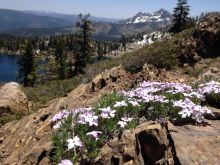
Tahoe is an amazing place to take in the coming of spring wildflowers.
Throughout the basin, nature offers a delightful arrangement of floral surprises in all shapes and sizes. The eclectic mixture of flora offers the eyes a candy shop of fun, and the different fragrances play with the olfactory senses, giving a special intrigue to the forest that only comes once a year. To be honest, the coming of the wildflowers is a favorite time of year for me. Not only does it increase the beauty of this impressive region of the world, but it also comes during a time when Tahoe is not inundated with tourism, making the venture out to play with the wildflowers one that can be experienced in solitude, giving a deeper appreciation for the loveliness that surrounds us.
To help you know what you are looking at, this blog post is dedicated to six of my favorite wildflowers that are frequently seen in the area. These are only a handful of examples of the beauty that comes with the blooming of Mother Nature's floral garden.
Spreading Phlox

Going by the names Phlox diffusa Benth, Mat Phlox and Spreading Phlox, this beautiful member of the perennial Phlox Family is known as an herb that decorates the forest floor. The plant is a low-to-the-earth shrub that forms in a circular woody mat formation and is known to sprawl widely, creating a dense ground cover. The leaves are yellow-green and needle-like but not spiny or sharp. The blossoms are reminiscent of a child's drawing of a flower and offer a sweet array of blossoms that range in color from white to lavender to purple to pink. The blossoms are smaller in size, yet so numerous that the leaves of the plant are hard to see, making it seem as if it is a blanket of flowers. Phlox is a native plant to the area and is known to have four subspecies inhabiting different parts of the Sierras. It is known to bloom here in May, June, July and August.
Large Mountain Fleabane
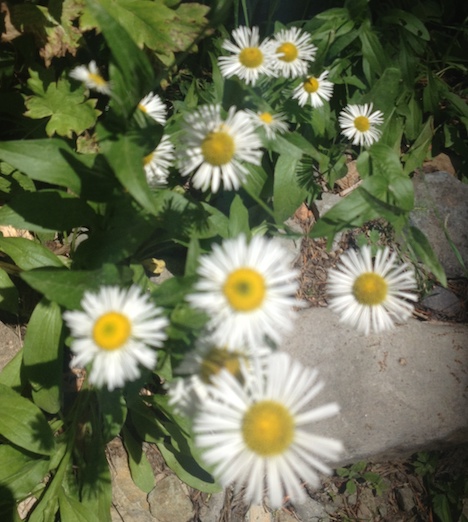
A perennial herb that is known to come in the colors of white and yellow, Large Mountain Fleabane is likened to a white daisy, yet the petals are thinner and more angular. It is a showstopper come June, July and August. A species of the family Asteraceae, it also goes by the names Coulter's Fleabane and Coulter's Daisy. It is native to the western United States and most enjoys moist forested environments or meadows as well as large expanses of land that are undeveloped and pristine. The plant grows eight to 28 inches in height, showing off an erect stem that has little to no branches, except for a few leaves at its base. Each stem has one to four blooms, sizing in at .4 to .8 inches wide. The center is filled with tiny bright yellow disc florets and the outer petals can number up to 140 individual ray florets.
California False Hellebore
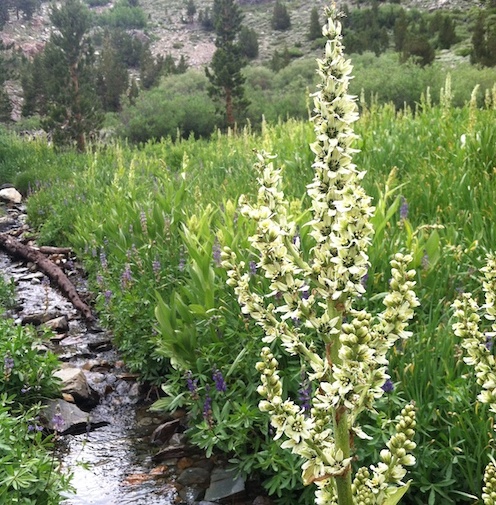
Although beautiful, the California False Hellebore, or California Corn Lily, is a plant that should be admired from afar. Considered extremely poisonous, California False Hellebore is a mighty plant that is known for growing to heights of one to two meters tall, producing an erect, unbranched, heavily leafed stem that looks much like a cornstalk, thus the name. The leaves can grow up to a whopping foot long. The flowers grow in clusters at the top of stem, usually having six white petals per flower and adorned with a green center, six stamens and a three-branched pistil. Enjoying undisturbed, moist soil, the California Corn Lily is a native western North American plant that does best around streams or wet meadows. It blooms with ferocity some years and other years is quiet. It is known to bloom best from July to August.
Rydberg's Penstemon

Considered one of the showier wildflowers that springs to life in the Sierra region, Rydberg's Penstemon, or Beardtongues, is a plant that actually loves all types of habitats including deserts, grasslands, forests, mountain meadows and alpine tundra. The third-largest genus of wildflowers of the interior west, Penstemon has more than 250 recognized species. The blooms range in a variety of colors including white, pink, red, purple and bright blue. The flower is made of five fused tubular corolla petals, with the varying species looking similar in appearance but differing by shape, the degree of pubescence as well as the pollen-bearing structures that exist with the flower. The blooms specific to the Rydberg's Penstemon are smaller than other Penstemon species and tend to be in a tight cluster. It is said that the Rydberg variation is smaller to adapt to the smaller size bees that tend to live in the region. This stunning flower is one of almost two dozen plant species that are named after Per Axel Rydberg, a well-known Swedish-American botanist that studied in the late 19th and early 20th centuries. This perennial is known to flower in June and July.
Giant White Fawnlily
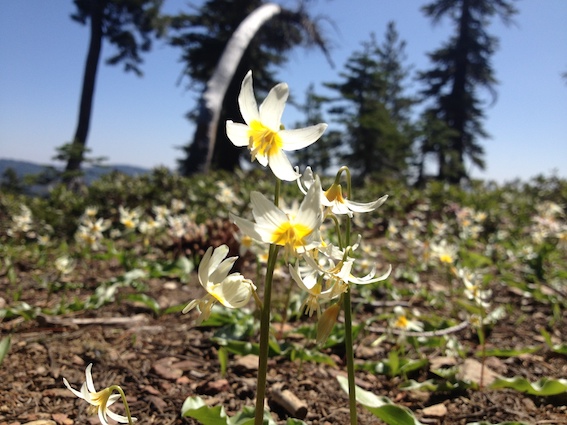
An absolutely adorable wildflower, the Giant White Fawnlily (Erythronium oregonum) is a bulb plant that is tiny in stature but large in beauty. Measuring in at three to five centimeters wide, this delicate flower sits atop a thin stalk that is decorated with a few lance-shaped leaves that lay upon the earth, measuring up to 22 centimeters in length and oftentimes mottled green, brown and white. The nimbly shoot that holds the bloom can reach 40 centimeters in height and can hold more than one flower. The tepals of each bloom are white with a yellow base and are, sometimes, enhanced with a red hue. The flower, itself, often faces the ground, with the tepals curving upward to reach toward the sun. These stunning flowers are pollinated by beetles and flies and are a favorite appetizer for bears. It was also a favorite food for Native Americans, enjoyed either raw or steamed. The Giant White Fawnlily blooms April, May and June.
Sierra Tiger Lily
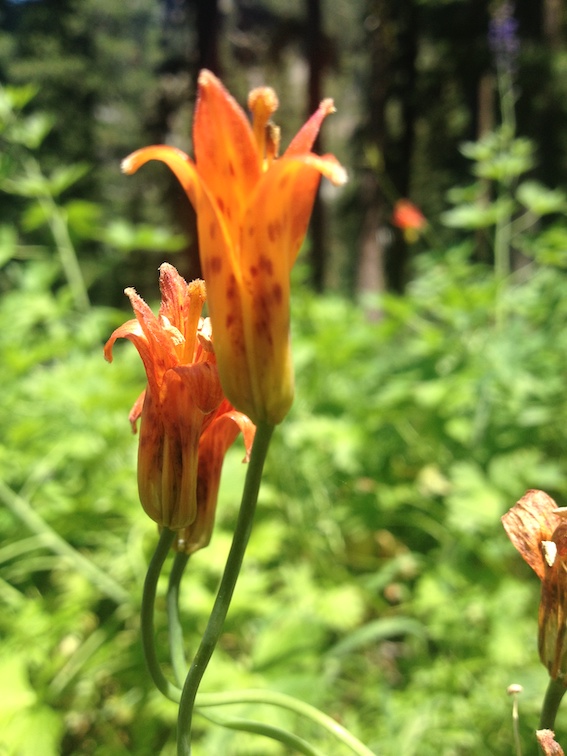
A wildflower that grows primarily in the Tahoe area from elevations 4,000 to 9,000 feet along stream banks and in meadows, the Sierra Tiger Lily, or Alpine Lily, also is known to frequent northwestern Nevada and southwestern Oregon. The blooms of the Sierra Tiger Lily are smaller in stature than most other lilies, but are more bell-shaped as a trade-off. Their coloring is a yellow-orange that fades to a rusty-orange tint, with the centers highlighted in yellow. The petals are accentuated with spots of purple or brown. Beyond the orange variety, there is also a pink version that grows in lower elevations of the Sierras, namely in El Dorado County, known as the ditch lily. The orange version enjoys healthy forests at high altitudes, can overtake large areas of space and is known to interbreed with other neighboring lilium species. The plants range in height from one to six feet tall, with the flowers measuring two to three inches across. The flowers bloom from June to August.
Click here for a list of places to hike in the Tahoe region. After enjoying the beauty of the wildflowers in the Sierras, check out one of the many entertaining events happening in the basin. Learn more at our Daytime and Nightlife sections.
Photos by Shanie Matthews


 A longtime Lake Tahoe local, Shanie is a freelance writer, Vinyasa Flow yoga teacher and positivity warrior. A true lover of the the gorgeous Tahoe region, she connects with the serenity of the mountains via skiing, biking and backpacking. She also believes in the gift of yoga and its way of allowing one to become his or her true best self, a passion she shares with the world with her online yoga studio.
A longtime Lake Tahoe local, Shanie is a freelance writer, Vinyasa Flow yoga teacher and positivity warrior. A true lover of the the gorgeous Tahoe region, she connects with the serenity of the mountains via skiing, biking and backpacking. She also believes in the gift of yoga and its way of allowing one to become his or her true best self, a passion she shares with the world with her online yoga studio.






